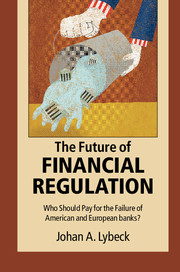Book contents
- Frontmatter
- Dedication
- Contents
- List of figures
- List of tables
- List of boxes
- Preface
- Acknowledgements
- List of abbreviations
- Introduction
- Part I A chronological presentation of crisis events January 2007 – December 2014
- Part II Bail-out and/or bail-in of banks in Europe: a country-by-country event study on those European countries which did not receive outside support
- Part III Bail-out and/or bail-in of banks in Europe: a country-by-country event study on those European countries which received IMF/EU support
- Part IV The TARP program and the bailing out (and bailing in) of US banks
- Part V Summary of the micro studies
- Part VI Political and regulatory responses to the crisis: to bail out or to bail in, that's the question
- 17 Future bail-outs in the United States under Dodd–Frank and OLA
- 18 Future bail-outs in the European Union under the Single Resolution Mechanism and the Bank Recovery and Resolution Directive
- Conclusion: toward host-country supervision and resolution?
- Addendum
- Bibliography
- Index
18 - Future bail-outs in the European Union under the Single Resolution Mechanism and the Bank Recovery and Resolution Directive
from Part VI - Political and regulatory responses to the crisis: to bail out or to bail in, that's the question
Published online by Cambridge University Press: 05 February 2016
- Frontmatter
- Dedication
- Contents
- List of figures
- List of tables
- List of boxes
- Preface
- Acknowledgements
- List of abbreviations
- Introduction
- Part I A chronological presentation of crisis events January 2007 – December 2014
- Part II Bail-out and/or bail-in of banks in Europe: a country-by-country event study on those European countries which did not receive outside support
- Part III Bail-out and/or bail-in of banks in Europe: a country-by-country event study on those European countries which received IMF/EU support
- Part IV The TARP program and the bailing out (and bailing in) of US banks
- Part V Summary of the micro studies
- Part VI Political and regulatory responses to the crisis: to bail out or to bail in, that's the question
- 17 Future bail-outs in the United States under Dodd–Frank and OLA
- 18 Future bail-outs in the European Union under the Single Resolution Mechanism and the Bank Recovery and Resolution Directive
- Conclusion: toward host-country supervision and resolution?
- Addendum
- Bibliography
- Index
Summary
Europe and the US contrasted
The last section of Chapter 17 tried to enumerate some of the things that distinguished and separated the handling of the financial crisis on the two sides of the Atlantic, thereby trying to begin to give an answer to the question as to why the American bail-out money has, in the main, been repaid while the European hasn't, and why US banks appear to be recovering from the crisis much faster than their European competitors.
American banks were already to begin with better capitalized than their European counterparts, thanks to the US focus on minimum leverage ratios rather than on capital in relation to risk-weighted assets. Table 21 showed asset/capital ratios of the major European megabanks being double those of the included US banks, even correcting for the difference between IFRS and GAAP accounting principles. When the crisis struck in 2007, large North American banks had, on average, a ratio of Tier 1 capital to risk-weighted assets of 9.42 percent which may be contrasted with 4.74 percent in Germany, 5.69 percent in Italy and 6.29 percent in Spain (but 11.68 percent in Britain). Obviously, adequate capital is only part of the story, albeit an important one.
Thanks not least to the opposition by the FDIC and its chair Sheila Bair, American (commercial) banks had avoided the disaster that Basel II brought to European banks from 2004 onwards by being forced to stay on Basel I with its fixed risk weights, a blessing in disguise as it turned out.
The long built-up experience by the FDIC in the efficient resolution of failing banks had few similarities in Europe where virtually everything – legal as well as institutional frameworks – had to be learnt and built from scratch. The FDIC had lived through the Latin American crises and the thrift crisis in the 1980s as well as the Asian and Russian crises in the 1990s, and the relevant pieces of legislation in the form of the FDIC Improvement Act of 1991 and the Federal Deposit Reform Act of 2005 were the happy results, as well as the changes brought to the bankruptcy legislation by the Bankruptcy Abuse Prevention and Consumer Protection Act of 2005.
- Type
- Chapter
- Information
- The Future of Financial RegulationWho Should Pay for the Failure of American and European Banks?, pp. 437 - 478Publisher: Cambridge University PressPrint publication year: 2016



